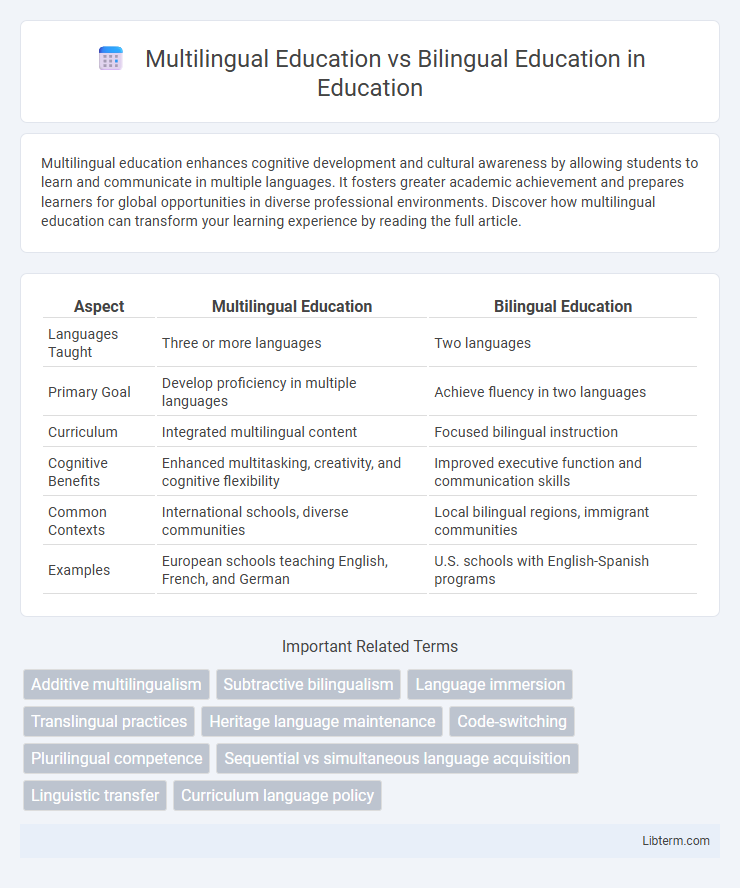Multilingual education enhances cognitive development and cultural awareness by allowing students to learn and communicate in multiple languages. It fosters greater academic achievement and prepares learners for global opportunities in diverse professional environments. Discover how multilingual education can transform your learning experience by reading the full article.
Table of Comparison
| Aspect | Multilingual Education | Bilingual Education |
|---|---|---|
| Languages Taught | Three or more languages | Two languages |
| Primary Goal | Develop proficiency in multiple languages | Achieve fluency in two languages |
| Curriculum | Integrated multilingual content | Focused bilingual instruction |
| Cognitive Benefits | Enhanced multitasking, creativity, and cognitive flexibility | Improved executive function and communication skills |
| Common Contexts | International schools, diverse communities | Local bilingual regions, immigrant communities |
| Examples | European schools teaching English, French, and German | U.S. schools with English-Spanish programs |
Introduction to Multilingual and Bilingual Education
Multilingual education involves teaching students in three or more languages, promoting comprehensive linguistic competence and cultural awareness, while bilingual education focuses on instruction in two languages to achieve fluency and literacy in both. Key models in bilingual education include transitional, maintenance, and dual-language programs, designed to support language development alongside academic achievement. Multilingual education expands beyond these frameworks by integrating diverse language skills to foster global communication and cognitive flexibility in increasingly interconnected societies.
Defining Bilingual Education
Bilingual education refers to instructional programs that use two languages for teaching academic content, aiming to develop proficiency in both the students' native language and a second language. This approach emphasizes balanced language development and cognitive benefits by integrating both languages in the curriculum. In contrast, multilingual education involves instruction in three or more languages, targeting broader linguistic diversity and intercultural competence.
Understanding Multilingual Education
Multilingual education involves instruction in three or more languages, promoting cognitive flexibility and cultural awareness beyond the two-language focus of bilingual education. It supports the development of advanced language proficiency and academic achievement by integrating multiple languages in the curriculum. Research indicates that multilingual education enhances metalinguistic skills and global communication competencies essential for diverse societies.
Key Differences between Bilingual and Multilingual Education
Bilingual education focuses on proficiency in two languages, typically emphasizing fluency and literacy in both the first and second languages, often within a structured academic context. Multilingual education, by contrast, incorporates three or more languages, promoting cultural diversity and cognitive development through exposure to multiple linguistic systems. Key differences include the scope of language acquisition, pedagogical goals, and the cognitive benefits associated with managing two versus several languages simultaneously.
Cognitive Benefits: Bilingual vs Multilingual Learners
Multilingual education enhances cognitive flexibility by engaging learners in multiple language systems, promoting advanced problem-solving and multitasking skills beyond those observed in bilingual learners. Bilingual education supports strong executive function development through managing two languages, improving attention control and working memory. Research indicates multilingual learners often demonstrate superior metalinguistic awareness and enhanced creativity compared to bilingual peers.
Cultural Impacts of Language Education Models
Multilingual education fosters cultural diversity and global awareness by integrating multiple languages, promoting cross-cultural understanding and respect among students. Bilingual education primarily strengthens the relationship between two specific cultures, enhancing identity and fluency in both languages while reinforcing cultural heritage. Both models influence cultural inclusivity, but multilingual education offers broader exposure to various cultural perspectives, enriching students' social and cognitive development.
Curriculum Design in Bilingual and Multilingual Settings
Curriculum design in multilingual education emphasizes the integration of three or more languages, fostering cultural diversity and cognitive flexibility through adaptive teaching strategies and content that reflect multiple linguistic contexts. In contrast, bilingual education curriculum prioritizes fluency and literacy in two languages, often structured with dual-language immersion or transitional programs to support balanced proficiency. Effective curriculum development in both settings requires alignment with language policies, learner needs, and sociolinguistic factors to optimize language acquisition and academic achievement.
Challenges and Solutions in Implementation
Multilingual education faces challenges such as resource allocation, teacher training, and curriculum development due to the need to support multiple languages simultaneously, whereas bilingual education often struggles with balancing proficiency levels and cultural representation between two languages. Solutions for multilingual education include investing in specialized teacher training, creating inclusive curriculum frameworks, and leveraging technology for personalized learning. In bilingual settings, effective implementation relies on community involvement, consistent language exposure, and adaptive assessment methods to ensure both languages develop equitably.
Global Perspectives and Trends in Language Education
Multilingual education emphasizes acquiring proficiency in three or more languages, reflecting global trends toward linguistic diversity and cultural integration, while bilingual education typically focuses on two languages, often prioritizing native and dominant languages for cognitive and academic benefits. International organizations like UNESCO promote multilingual education to support inclusive education and socio-economic development in multicultural societies. Emerging global perspectives highlight the importance of multilingualism in enhancing cross-cultural communication, global competitiveness, and lifelong learning in an interconnected world.
Choosing the Right Model: Factors to Consider
Choosing the right language education model depends on factors such as the learner's goals, community language needs, and available resources. Multilingual education supports proficiency in three or more languages, promoting cognitive flexibility and cultural awareness, while bilingual education focuses on two languages, often enhancing academic performance in core subjects. Decision-makers should evaluate student demographics, curriculum objectives, and teacher expertise to optimize language acquisition outcomes.
Multilingual Education Infographic

 libterm.com
libterm.com